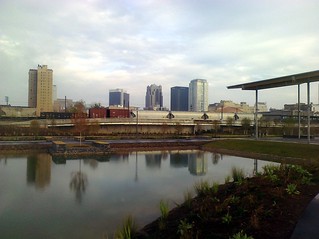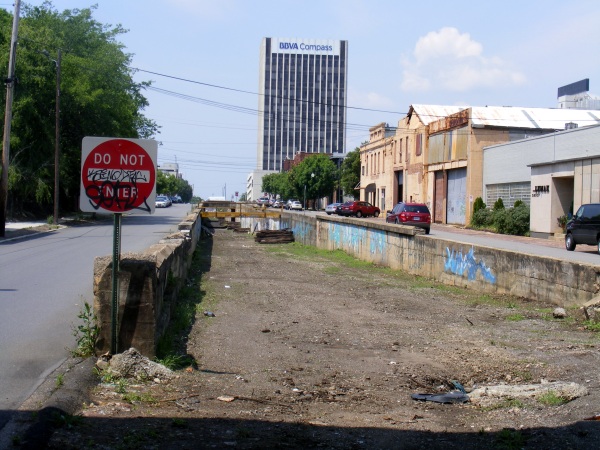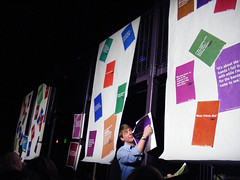 There are a lot of people looking to tomorrow, 12/12/12, as a day of significance. It could be a day that marks a new chapter and an evolutionary leap for a community.
There are a lot of people looking to tomorrow, 12/12/12, as a day of significance. It could be a day that marks a new chapter and an evolutionary leap for a community.
I’d argue a decision of that significance for the future of Birmingham was made late Tuesday morning when the Birmingham City Council reconsidered agenda item 34 at the end of their meeting.
That’s when they decided to unanimously approve the sale of Lot D, the site used as the muse for the Community Foundation of Greater Birmingham‘s Prize 2 The Future idea competition last year, to Alabama Power for $2.95 million– based on a recommendation from the city’s Budget and Finance committee. The redevelopment project that has been hinted at when talking about this purchase could include a conversion of the soon-to-be dormant steam plant currently operated across the street by the utility.
Many would find it hard to not agree the property’s location is not ideal or pivotal to the current level of activity underway south of the railroad tracks. Despite years of some disliking when Southside was referred to as downtown, it may become an essential part of its genetic makeup fairly soon. Those who remember the residential development known as The Standard originally slated to go across from Railroad Park at 18th St. well before the urban oasis was completed may notice soil is being moved, perhaps suggesting it may yet move forward, in some form, soon. Keep in mind that Rev Birmingham (formerly ONB/MSB) has promised upcoming announcements about two residential projects close to the park in their recent newsletter.
It got me wondering about what kind of project could be capable of continuing the transform the City of Birmingham. I started thinking about the areas surrounding the parks that Railroad Park are often compared with and found a common theme – one that could lead to a proposal as transformative as the ones considered during last year’s idea competition.
While folks like to compare Railroad Park to New York City’s Central Park, there are many native New Yorkers who’d find Bryant Park a better comparison and one that leads to far more potential. The park acts and looks like more of a living room than most, allowing for an outdoor reading room, movie screenings, fashion shows. The first use included in that list is made possible in part because of the park’s next door neighbor, the main branch of The New York Public Library.
A similar situation is found at Chicago’s Millennium Park, as its eastern edge is defined by The Art Institute of Chicago. There are other examples of civic cultural institutions anchoring gathering spaces throughout the country.
This is why seeing two people who were in attendance at today’s meeting made me think of a crazy idea for Alabama Power’s rumored project – Kate Nielsen, the Community Foundation’s executive director, and Gail Andrews, the director for the Birmingham Museum of Art.
Ms. Nielsen spoke in support of the sale of the property at Monday’s committee meeting, with the Foundation posting a supportive statement on its site yesterday afternoon. Ms. Andrews enjoys overseeing the largest municipal museum of art in the Southeast, though at times at least 60% of the collection is not available for viewing. An expanded home or an opportunity to establish a second location (similar to what the Guggenheim Museum was able to do in New York years ago), would be extremely beneficial, especially as the eyes of the world turn to Birmingham in the coming months.
 There are others that could benefit from such an opportunity – including the Birmingham History Center (though it would still be pretty cool to see them end up at The Powell School long term). All in all, it would enable a cultural stream to run through the middle of our greater downtown area – the ballpark, Railroad Park, Line Park, Sloss Furnaces – connecting our city’s present (an expanding medical-based economy) with the heart of it’s central business district. Now think about it expanding west…
There are others that could benefit from such an opportunity – including the Birmingham History Center (though it would still be pretty cool to see them end up at The Powell School long term). All in all, it would enable a cultural stream to run through the middle of our greater downtown area – the ballpark, Railroad Park, Line Park, Sloss Furnaces – connecting our city’s present (an expanding medical-based economy) with the heart of it’s central business district. Now think about it expanding west…
You may not be able to float down that stream per se, but imagine the potential dreamers such an idea could influence and inspire in our fair city? It’s potentially enough to help drive a transformation…
André Natta is the stationmaster for bhamterminal.com





 This year’s
This year’s  A drive along 1st Avenue South heading east contains a significant yet subtle development for those able to stop and take a look. You’ll notice the absence of rails and ties both in the area known as
A drive along 1st Avenue South heading east contains a significant yet subtle development for those able to stop and take a look. You’ll notice the absence of rails and ties both in the area known as  Is parking availability really a major issue in Birmingham, AL?
Is parking availability really a major issue in Birmingham, AL?


Why is the downtown Publix really a game-changer?
Now, I’ve lived in the greater downtown area since 2004, and I’ve always had as few as four and as many as six major options available to choose from within 2 miles, but I had to drive to them. When people ask me “Where and how do you get groceries?” I admit I’ve long ago started replying by asking them, “Well, where and how do you get yours?” I get a stunned look, but most times they seem to get what I’m saying. That said, it’s not an option readily or easily available to a significant number of our city’s residents.
This leads to my first reason why it’s a game-changer:
It’s more about WALKING now than DRIVING. Yes, there’s a parking deck that will sit between the ground floor space and the 36 “loft-style” apartments planned for the top the building. The vehicles using these spaces though will be off-street and out of sight. The idea of needing to circle forever to find a spot or the installation of a surface parking lot to handle capacity doesn’t even come up in conversation – and that’s a great thing. It suggests developers realize there will be enough people within walking distance to support its operation. It takes away reliance on an automobile to make a development like this one work.
It means it should be easier to get other national and regional retailers to consider locating a business downtown. It also makes it easier to get those same retailers to start looking at options in neighborhoods throughout the city. It could potentially make the issue of placing parking immediately adjacent to their business less of a sticking point. Dare it be suggested it could also be the first step toward a re-write of the city’s parking regulations and a rethinking of its minimum requirements?
It’s downtown. Actually, this may be an even bigger issue for me and one I’m excited about watching evolve. The proposed building is sitting along 20th Street South. When I first moved here nearly ten years ago, I referred to that area as being downtown while having a conversation with a native; I was chastised immediately because “it was not downtown, it was Southside. Downtown starts on the other side of the tracks.”
It was weird, as most New Yorkers refer to pretty much all of Manhattan as “downtown” no matter which of the other four boroughs you live. I’d also moved here after working for an agency charged with the revitalization of “greater Downtown” Savannah, not just its famous historic district. As a result, I’ve long considered the areas surrounding the city center part of greater downtown Birmingham. It makes sense especially when you get a chance to see just how small the expanded area still is in relation to the rest of the city.
The announcement of this grocery store lends itself to a new approach involving population growth in the urban core focused on eventually seeing people choosing to live in the single-family home dense portions of Druid Hills, Fountain Heights, and Norwood (in addition to others like Titusville, Smithfield, and College Hills) after spending a couple of years living in an apartment located nearby in the city center. Every major news outlet in the city referred to the project’s location area as downtown, suggesting the shift in perspective (one long championed by REV Birmingham and its predecessors) is finally starting to happen. The change in perspective also means a realization about the choices available to someone thinking about their next move.
The changes that come as a result of this and other projects will be quick. The changes at face value will be good for the city. The question right now as we get ready to start watching this happen is “Are we ready for what we’ve been asking for all of these years?”
André Natta is the stationmaster for bhamterminal.com.
Leave a comment
Posted in Birmingham, Commentary, development
Tagged downtown, game-changer, grocery store, Publix, UAB